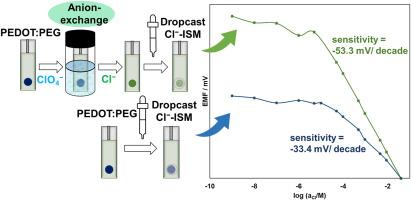溶液可加工全固态氯化物选择电极:增强阴离子掺杂交换的灵敏度
IF 6
2区 化学
Q1 CHEMISTRY, ANALYTICAL
引用次数: 0
摘要
离子选择电极(ISEs)广泛应用于许多行业,近年来的研究重点是通过用固体触点代替液体填充溶液来实现其小型化。溶液处理因其简单和可扩展性而成为制备固体接触式ISEs (SC-ISEs)的首选方法。然而,虽然有许多可溶液加工的阳离子sc - ise,但由于与固体触点的相容性较差,阴离子sc - ise仍然是一个挑战。许多阴离子sc - ise仍然是通过复杂的技术制备的,例如固体接触的电聚合。因此,需要能够与阴离子选择膜(ISMs)良好结合的溶液可加工固体触点策略。在这里,我们报道了在滴铸ISM之前,通过阴离子交换聚(3,4-乙烯二氧噻吩)-聚乙二醇(PEDOT-PEG)固体接触制备了完全可溶液加工的氯化物(Cl−)SC-ISE。PEDOT-PEG阴离子交换后灵敏度显著提高,在宽动态范围(0.05 M至6.03 μM)内,最佳SC-ISE表现出接近nernstian的响应(- 53.3±0.5 mV/decade,而未交换的SC-ISE为- 33.4±1.8 mV/decade)。我们的SC-ISE还对磷酸盐(H2PO4−),碳酸氢盐(HCO3−)和醋酸盐(CH3CO2−)具有优异的选择性,并且可以在最短的调理时间内使用,并且可以长时间使用。最后,考虑到Cl -传感在医疗保健中的重要性,我们还展示了Cl - SC-ISE在传感多种合成生物样品(如汗液、尿液和血液以及真正的人类汗液(前臂样品))方面的潜力。这项工作不仅证明了我们的阴离子交换协议的多功能性,而且还进一步了解了不同的增强机制-灵敏度或选择性-取决于离子载体是否存在于ISM中。我们的研究表明,无论机制如何,我们简单有效的方案都可以缓解原始性能不佳的问题,因此可以很容易地扩展到多种阴离子选择性sc - ise的可扩展制备中。本文章由计算机程序翻译,如有差异,请以英文原文为准。


Solution-processable all-solid-state chloride-selective electrode: Enhanced sensitivity from anion dopant exchange
Ion-selective electrodes (ISEs) are widely used in many industries, with recent research focusing on their miniaturization by replacing the liquid filling solutions with solid-contacts. Solution-processing is the preferred method for preparing solid-contact ISEs (SC-ISEs) due to its ease and scalability. However, while there are many solution-processable cationic SC-ISEs, this remains a challenge for anionic SC-ISEs due to poorer compatibility with the solid-contacts. Many anionic SC-ISEs are still prepared by complex techniques, such as electropolymerisation of the solid-contact. Thus, strategies for solution-processable solid-contacts which can interface well with anionic ion-selective membrane (ISMs) are required. Here, we report the fabrication of a fully-solution-processable chloride (Cl−) SC-ISE by anion exchange of poly(3,4-ethylenedioxythiophene)-polyethylene glycol (PEDOT-PEG) solid-contact before drop-casting the ISM. Significant improvement in sensitivity was observed after PEDOT-PEG anion exchange, with the optimal SC-ISE exhibiting near-Nernstian response (−53.3 ± 0.5 mV/decade, versus −33.4 ± 1.8 mV/decade for the unexchanged SC-ISE) across a wide dynamic range (0.05 M–6.03 μM). Our SC-ISE also exhibited excellent selectivity against phosphate (H2PO4−), bicarbonate (HCO3−) and acetate (CH3CO2−) and could be utilized with minimal conditioning time and for prolonged usage. Finally, given the importance of Cl− sensing in healthcare, we also demonstrated the potential of our Cl– SC-ISE in sensing multiple synthetic biological samples such as sweat, urine and blood, and real human sweat (forearm samples). This work not only demonstrates the versatility of our anion exchange protocol, but also furthers the understanding of the different enhancement mechanisms – sensitivity or selectivity – depending on whether an ionophore was present in the ISM. We showed that regardless of the mechanism, our simple and efficient protocol could mitigate the issue of the original underperformance and can thus be readily extended to the scalable preparation of multiple types of anion-selective SC-ISEs.
求助全文
通过发布文献求助,成功后即可免费获取论文全文。
去求助
来源期刊

Analytica Chimica Acta
化学-分析化学
CiteScore
10.40
自引率
6.50%
发文量
1081
审稿时长
38 days
期刊介绍:
Analytica Chimica Acta has an open access mirror journal Analytica Chimica Acta: X, sharing the same aims and scope, editorial team, submission system and rigorous peer review.
Analytica Chimica Acta provides a forum for the rapid publication of original research, and critical, comprehensive reviews dealing with all aspects of fundamental and applied modern analytical chemistry. The journal welcomes the submission of research papers which report studies concerning the development of new and significant analytical methodologies. In determining the suitability of submitted articles for publication, particular scrutiny will be placed on the degree of novelty and impact of the research and the extent to which it adds to the existing body of knowledge in analytical chemistry.
 求助内容:
求助内容: 应助结果提醒方式:
应助结果提醒方式:


